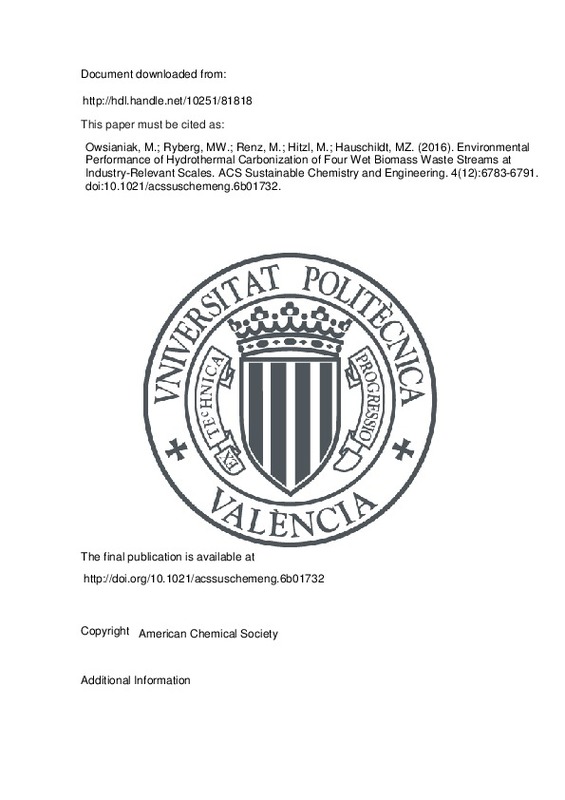JavaScript is disabled for your browser. Some features of this site may not work without it.
Buscar en RiuNet
Listar
Mi cuenta
Estadísticas
Ayuda RiuNet
Admin. UPV
Environmental Performance of Hydrothermal Carbonization of Four Wet Biomass Waste Streams at Industry-Relevant Scales
Mostrar el registro sencillo del ítem
Ficheros en el ítem
| dc.contributor.author | Owsianiak, Mikolaj
|
es_ES |
| dc.contributor.author | Ryberg, Morten W.
|
es_ES |
| dc.contributor.author | Renz, Michael
|
es_ES |
| dc.contributor.author | Hitzl, Martin
|
es_ES |
| dc.contributor.author | Hauschildt, Michael Z.
|
es_ES |
| dc.date.accessioned | 2017-05-26T10:27:32Z | |
| dc.date.issued | 2016-12 | |
| dc.identifier.issn | 2168-0485 | |
| dc.identifier.uri | http://hdl.handle.net/10251/81818 | |
| dc.description.abstract | [EN] Hydrothermal carbonization (HTC) of green waste, food waste, organic fraction of municipal solid waste (MSW), and digestate is assessed using life cycle assessment as a potential technology to treat biowaste. Water content of the biowaste and composition of the resulting hydrochar are important parameters influencing environmental performance. Hydrochar produced from green waste performs best and second best in respectively 2 and 10 out of 15 impact categories, including climate change, mainly due to low transportation needs of the biowaste and optimized pumping efficiency for the feedstock. By contrast, hydrochar produced from the organic fraction of MSW performs best in 6 impact categories, but has high potential impacts on human health and ecosystems caused by emissions of toxic elements through ash disposal. The greatest potential for environmental optimization for the HTC technology is in the use of heat and electricity with increasing plant size, but its overall environmental performance is largely influenced in a given geographic location by the incumbent waste management system that it replaces. Impact scores are within the range of existing alternative treatment options, suggesting that despite being relatively immature technology, and depending on the geographic location of the plant, HTC may be an attractive treatment option for biowaste. | es_ES |
| dc.description.sponsorship | This research was funded by the European Commission under the seventh framework program; SME-2013-2: NEWAPP, grant agreement 605178. | en_EN |
| dc.language | Inglés | es_ES |
| dc.publisher | American Chemical Society | es_ES |
| dc.relation.ispartof | ACS Sustainable Chemistry and Engineering | es_ES |
| dc.rights | Reserva de todos los derechos | es_ES |
| dc.subject | Bioenergy | es_ES |
| dc.subject | Biowaste | es_ES |
| dc.subject | Hydrochar | es_ES |
| dc.subject | Life cycle assessment | es_ES |
| dc.subject | Upscaling | es_ES |
| dc.subject.classification | QUIMICA INORGANICA | es_ES |
| dc.title | Environmental Performance of Hydrothermal Carbonization of Four Wet Biomass Waste Streams at Industry-Relevant Scales | es_ES |
| dc.type | Artículo | es_ES |
| dc.identifier.doi | 10.1021/acssuschemeng.6b01732 | |
| dc.relation.projectID | info:eu-repo/grantAgreement/EC/FP7/605178/EU/New technological applications for wet biomass waste stream products/ | es_ES |
| dc.rights.accessRights | Abierto | es_ES |
| dc.description.bibliographicCitation | Owsianiak, M.; Ryberg, MW.; Renz, M.; Hitzl, M.; Hauschildt, MZ. (2016). Environmental Performance of Hydrothermal Carbonization of Four Wet Biomass Waste Streams at Industry-Relevant Scales. ACS Sustainable Chemistry and Engineering. 4(12):6783-6791. https://doi.org/10.1021/acssuschemeng.6b01732 | es_ES |
| dc.description.accrualMethod | S | es_ES |
| dc.relation.publisherversion | http://doi.org/10.1021/acssuschemeng.6b01732 | es_ES |
| dc.description.upvformatpinicio | 6783 | es_ES |
| dc.description.upvformatpfin | 6791 | es_ES |
| dc.type.version | info:eu-repo/semantics/publishedVersion | es_ES |
| dc.description.volume | 4 | es_ES |
| dc.description.issue | 12 | es_ES |
| dc.relation.senia | 325618 | es_ES |
| dc.contributor.funder | European Commission |







![[Cerrado]](/themes/UPV/images/candado.png)

